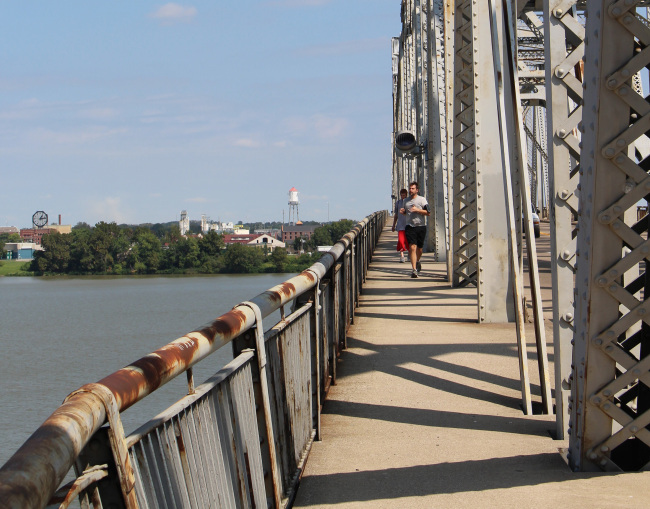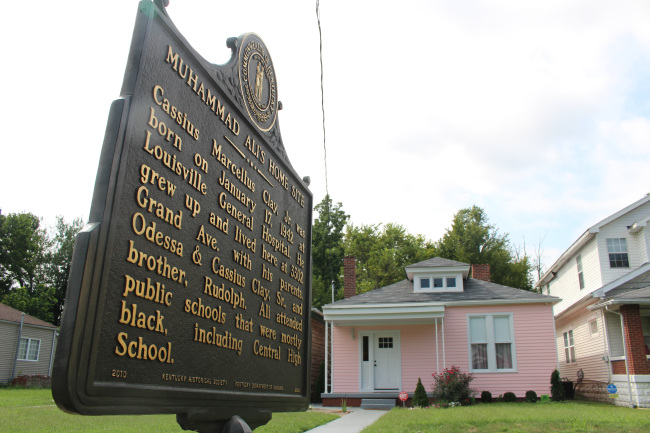LOUISVILLE, Kentucky -- Above the bar at Jack Fry’s, a favorite Louisville dining destination on busy Bardstown Road, the walls are adorned with pictures of racehorses and people who know racehorses.
In a corner are photos of The Greatest.
Almost everyone in the city and in the world beyond Bardstown Road knows the man in those photos. Louisville is inviting everyone to get to know him a little better.
Muhammad Ali died on June 3. He was 74. He was brought back to Louisville, where he was born in 1942 as Cassius Marcellus Clay Jr., to honor him and cheer him one more time, and here he’ll stay.
It has been “Ali’s Louisville” from the time he brought home gold in the 1960 Rome Olympics, but now it’s official: There’s a brochure, with sights to see and a map to guide us. But the sights are only part of it.
Liz, a waitress at Fry’s, set down a plate of shrimp and grits. She never worked his table but saw him here a few times.
“Everybody,” she said, “has, like, a story.”
And that’s what makes this Ali’s city.
The grave is in the brochure.
Col. Sanders is buried in Cave Hill Cemetery. So is George Rogers Clark, a hero of the Revolution, and so is Mildred Hill, credited with writing the “Happy Birthday” melody, and so are Union and Confederate soldiers.
 |
The Second Street Bridge, little changed since a teenage Cassius Clay -- as legend would have it --tossed his Olympic gold medal from there into the Ohio River below. Or didn’t. (Alan Solomon/Chicago Tribune/TNS) |
Muhammad Ali rests in Section U. The marker is simple -- just his name cut into a small, dark granite slab.
“You’d think they’d make it look nice,” said a man who needed multiple tries on his moped before finding it. “I thought it’d be bigger and stuff. It don’t even have his birth date on it.”
You a fan?
“Ain’t everbody?”
A couple in a sedan drove up quietly, stopped without leaving the car and turned off the engine. The driver motioned to come on by and chat.
Woody Zorn is 76, retired from the Louisville Police Department after 40 years, and he had a story: His grandfather was Kentucky’s first licensed boxing judge, he’d go watch the fights, and that’s where, as a young man, he had met the slightly younger Cassius Clay.
“I always sat in the same place,” he said, “and I love popcorn. He knew I always had popcorn, so he would come and sit next to me -- and eat my popcorn. It was almost like a standing joke with us.”
During the week after Ali’s death, Zorn said, as the city mourned then celebrated then buried the man, something remarkable happened in Louisville: nothing.
“It was like going back 20 years,” he said. “No shootings or murders.”
There will be a larger memorial, said Lee Payne, the cemetery’s head of security. As for the current marker, “We put that there, just to let people know he’s here.”
For 14 years -- 1947 to 1961 -- Cassius Clay Jr., his mother, father and younger brother, Rudy (today, Rahman Ali), lived in a little house at 3302 Grand Ave. in Louisville. In 2013, it was abandoned and falling apart. Less than a week before the boxer’s death, on May 28, the Muhammad Ali Childhood Home, restored to its original pink color, opened to the public. It’s in the brochure.
 |
Boxing gloves and other pugilistic gear at Louisville TKO Boxing await young people who, like the pictured 12-year-old Cassius Clay, dream of someday being the greatest -- or at least pretty good. (Alan Solomon/Chicago Tribune/TNS) |
The house was closed to visitors the day I stopped by (hours are Thursday through Sunday; I’d picked Wednesday), but life went on. A few doors away, Linda Calloway, 63, and a friend, Charles Crawford, 74, were passing the time on the front porch of the house where Calloway grew up, her mother’s house.
They had stories.
“We used to go to their house, and he’d tell jokes and stuff,” Calloway said. “He’d tell us scary stories and have us running.”
“He ran and ran and ran. He was like another Forrest Gump. Everywhere he went, he ran. Ran to school,” she said.
Crawford was in Ali’s 1960 senior class at Central High. “He was always kidding and joking. Always.”
The funeral procession came to Grand Avenue. It was some procession.
“He was deserving,” Crawford said. “He was not just ‘United States.’ He was worldwide. A lot of people don’t really understand.”
Early the next day, the house now open, four tourists were there. Three were from London. “I’m a big fan of his,” said Kally Singh, a London police officer. “I’ve just come from the grave.”
The guide was Sonny Fishback, who grew up nearby. “He was one of the greatest friends you ever wanted to have,” he said. “But I never believed nothing he said -- up until he won that Olympics.”
The Muhammad Ali Center, opened in 2005 in the heart of downtown, is a magnificent museum. It’s the essential stop in the brochure. Hours’ worth of exhibits provide not only Ali artifacts and timeline material but context to help us, and future generations, understand the Cassius Marcellus Clay Jr./Muhammad Ali saga in all its epic-ness -- from his growing up in segregated Louisville during a time of tension and change to his successes in the ring to his conversion to Islam to his decision to refuse induction into the military, and more.
 |
The four-room house in which Odessa and Cassius Clay Sr. brought up their two sons. It’s now open to the public. (Alan Solomon/Chicago Tribune/TNS) |
Lots of film, of his fights and of indelible declarations like this one: “I’m young, I’m handsome, I’m fast, I’m pretty and I can’t possibly be beat.”
Here, in the center, is detailed how the teenage Clay returned from Rome in 1960 with a gold medal around his neck, was feted by the mayor and all of Louisville -- only to be refused service at a lunch counter. Enraged, he walked to the Second Street Bridge (visible from the center’s windows) and hurled the medal into the Ohio River.
“We asked him when we created the center, we said, ‘Muhammad, we don’t want to put a lie on the wall,’” said Becky Morris, speaking for the center. “‘Did you actually throw it over?’ And he was very noncommittal with his answer. So it’s up there in our exhibit as ‘a legend.’”
In the brochure: a Boxing Glove Monument, in the Smoketown neighborhood. Skip it. His high school -- a photo opportunity. The Columbia Gym, where a cop named Joe Martin introduced young Clay to boxing, is in the brochure, too, but no longer exists; it’s now a student lounge at Spalding University, with a ping-pong table.
Not in the brochure: In a converted garage on Breckinridge Street is a functioning gym, the nonprofit Louisville TKO Boxing. Opened in March 2015, a standing Ali is prominent on an outside mural; inside, boxing stuff, the unmistakable aroma of athlete sweat and large blowups of the champion, one at 12 years old.
Kids mostly – dozens -- will arrive around 4 p.m., after school. (Sign: “No hooks before books.”)
“We’ve a lot of kids that we get off the street,” said a coach, Mike Tee, “and train them to compete.
“They want to be him. Just as great.”
And they will give Coach Tee, who never met Muhammad Ali, new Louisville stories to tell.
By Alan Solomon
Chicago Tribune
(TNS)










